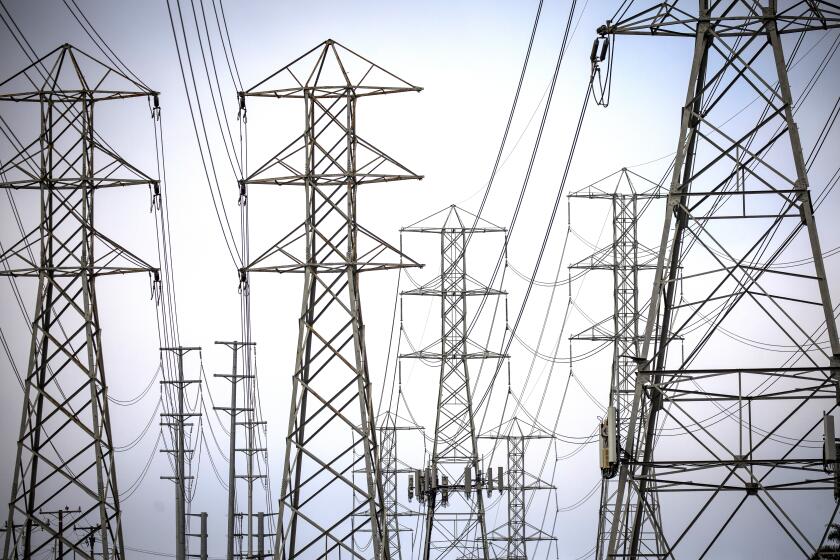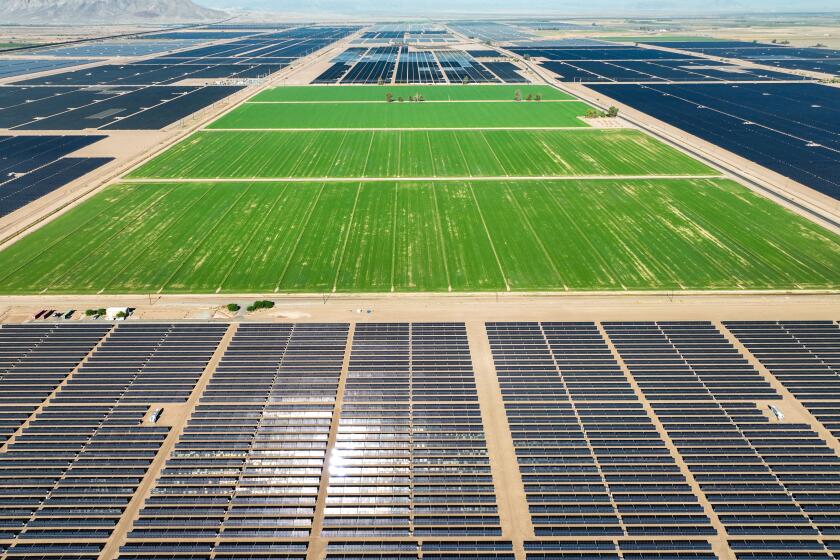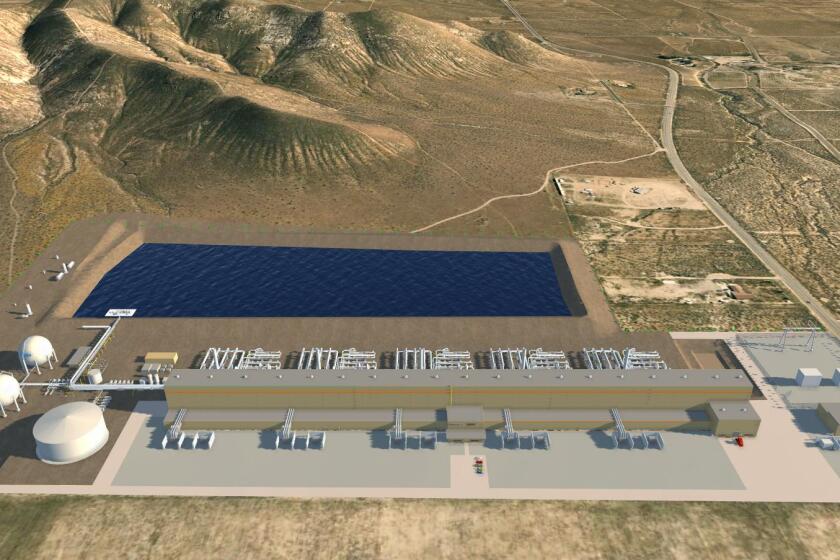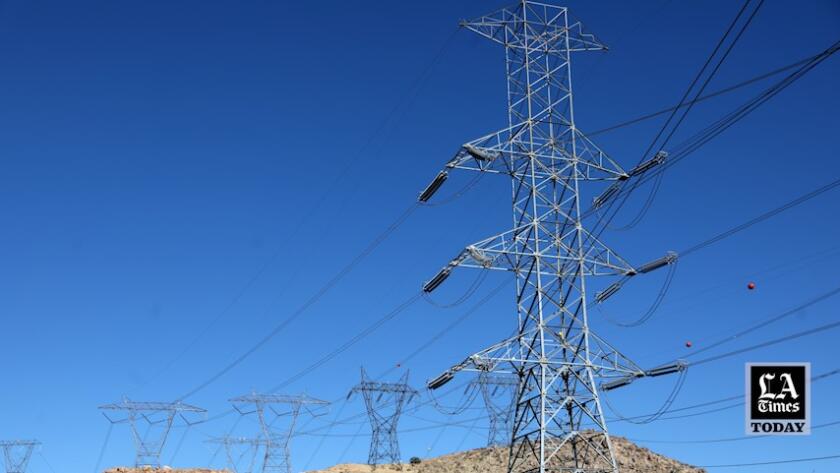A new charge is coming to your electric bill. Will it make California rates more affordable?
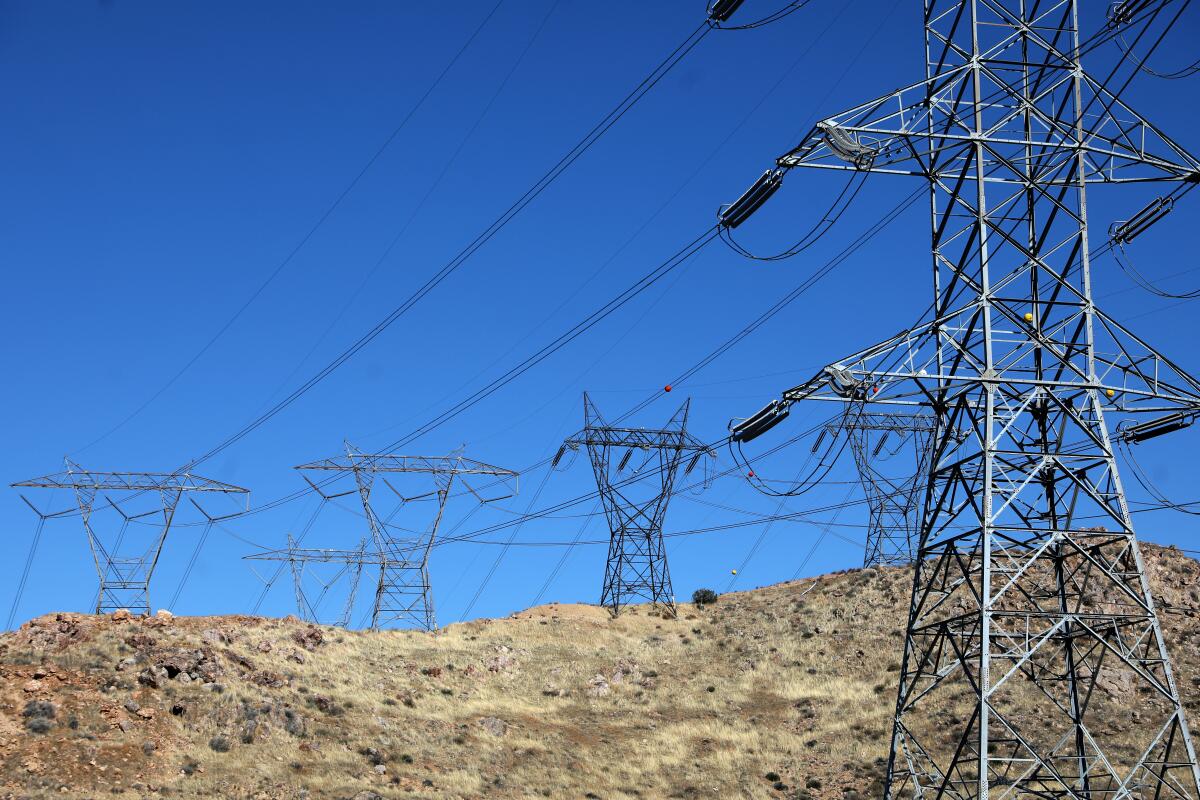
- Share via
In an attempt to make rising electricity bills more affordable, California will institute a fixed monthly charge on residential ratepayers that will vary according to household income.
The precise dollar amount and other details will be determined by the California Public Utilities Commission, with a final decision approved by mid-2024 and fully implemented in 2025.
The move will affect all ratepayers across the state who receive electricity service from the state’s three big investor-owned utilities: Southern California Edison, San Diego Gas & Electric and Pacific Gas & Electric.
The new income-based fixed charge will pertain only to electricity and is mandated by the state as part of a sweeping energy bill the Legislature passed last summer.
Friday marked the deadline for the power companies and other stakeholders, such as consumer groups, to submit proposals to the commission outlining how the new fixed-charge system should work.
Wind turbines, solar panels and power lines are needed to confront climate change. But they’re also reshaping the West — and not always for the better.
As per commission instructions, all proposals must be composed of at least three income brackets.
SDG&E, PG&E and Edison turned in a joint submission. Here’s how their proposal would play out for customers:
- Households earning less than $28,000 a year would pay a fixed charge of $15 a month on their electric bills in Edison and PG&E territories and $24 a month in SDG&E territory.
- Households with annual income from $28,000 to $69,000 would pay $20 a month in Edison territory, $34 a month in SDG&E territory and $30 a month in PG&E territory.
- Households earning from $69,000 to $180,000 would pay $51 a month in Edison and PG&E territories and $73 a month in SDG&E territory.
- Those with incomes above $180,000 would pay $85 a month in Edison territory, $128 a month in SDG&E territory and $92 a month in PG&E territory.
Creating the income-based fixed charge, according to the proposal by the utilities, would lower Edison’s average electricity rate to about 24 cents a kilowatt-hour from about 36 cents — a reduction of about 33%.
If the numbers hold up, that would lower the total electric bill of a middle-income Edison residential customer by about $4 a month — to about $169 from $173 for households using 500 kilowatt-hours of electricity a month.
The state needs to invest billions of dollars in new electric lines to meet its climate change goals.
And the savings would, according to the proposal, grow when more electricity is consumed. Edison estimated that if the same middle-income household used 600 kilowatt-hours in one month, the bill would come to $228 instead of $258 (a difference of $30).
“The status quo isn’t going to work,” said Scott Crider, a senior vice president at SDG&E. “As we start to see more utilization of electricity and more reliance on electricity, we have to have fundamental reform on electric rates, and we think this is the best way to go.”
Changing the rate structure does not make energy costs go away; instead, it essentially reshuffles them in an effort to offer relief to financially vulnerable customers and help California meet its decarbonization mandates.
The utilities’ proposal anticipates a savings of $300 a year for lower-income customers in SDG&E’s service territory, while reducing average electricity rates for all customers, adding more predictability to bills and making the adoption of all-electric appliances and vehicles more attractive.
“This is not a rate increase,” Crider said. “We are not asking to collect any more money from our residential customers, and SDG&E will not make one penny in additional profit as a result of this.”
Water supplies in the Imperial Valley are dwindling. Converting more farmland there to solar energy generation can help prevent climate disaster.
How did this come about?
The proposal is a result of Assembly Bill 205, a sprawling piece of legislation passed last summer in Sacramento and signed into law by Gov. Gavin Newsom.
Most of the attention in AB 205, referred to as the “energy trailer bill,” focused on the creation of a “strategic reliability reserve” overseen by the California Department of Water Resources.
But stacked among the bill’s provisions was a requirement that the CPUC adopt a fixed monthly charge based on household income to help pay for electricity delivery infrastructure, such as poles, wires, meters and customer service.
Instituting the new charge comes as monthly bills keep climbing across California, fueling worries about energy affordability.
In addition to the costs of energy, electricity rates include expenses from other elements — such as “public purpose programs” that help lower-income Californians pay their utility bills, spending to reduce wildfire risk, and efforts to curb the use of fossil fuels so California can meet its goal to derive 100% of the state’s electricity from carbon-free sources by 2045.
A 131-page report by the CPUC in May 2022 predicted higher power bills for customers of all three of the big investor-owned utilities. It forecast that between the first quarter of 2022 and the end of 2025, PG&E’s rates will rise 26%, SDG&E’s will go up 24% and Southern California Edison’s would increase 16%.
Replacing agriculture with solar panels could help solve the West’s energy and water crises. But farmers are fighting back.
A proposal with different price points
TURN, the Utility Reform Network, a consumer group in San Francisco, filed its own submission Friday in conjunction with the Natural Resources Defense Council, a nationally known environmental group.
Their proposal calls for lower-income households on the California Alternative Rates for Energy (CARE) and the Family Electric Rates Assistance (FERA) programs to pay a fixed charge of just $5 a month.
Households making up to $150,000 would pay a fixed charge of about $40 a month, and those earning more than $150,000 would pay around $60 a month.
TURN staff attorney Matthew Freedman said the proposal is aimed at helping low-income customers, and he expects it to lead to “no material impact” on the monthly bills for middle-income customers in SDG&E’s service territory.
Lower-income customers “are struggling to make ends meet and are facing really an affordability crisis of epic proportions,” Freedman said. “So we’re really focused on using this as a way to promote affordability and equity.”
Want to fight climate change while keeping the lights on? Compressed air storage could be key.
The idea of establishing a fixed charge based on income level has been bandied about for years in California public policy circles.
The Energy Institute at the Haas School of Business at UC Berkeley joined with the Next 10, a San Francisco Bay Area nonprofit, last fall to issue a 35-page report focused on redesigning residential rates. The report’s suggestions included adopting a fixed monthly charge based on household income.
UC Berkeley associate professor James Sallee, one of the paper’s authors, said that because the fixed charge is designed for customers to save more money as they increase electricity consumption, it will encourage ratepayers to adopt cleaner technologies that align with the state’s clean energy mandates.
“Suppose you want to hook up your electric car and you want to electrify your home heating or your water heater,” Sallee said. “You’re going to be rewarded under this rate structure because you’re going to be consuming, on net, more electricity from the grid.”
The Next 10 report also called for taking some of the grid costs that are now included in rates — such as wildfire funding and public purpose programs — and moving them onto the state budget instead. But that suggestion is not part of the AB 205 mandate.
Billionaire Phil Anschutz — who owns the Coachella music festival, the Los Angeles Kings hockey team and L.A.’s Crypto.com Arena — is preparing to build the nation’s largest wind farm. We traveled the route.
Potential problems
One potential stumbling block to implementing a monthly fixed charge will be collecting and verifying the annual income data from each household. It will undoubtedly raise privacy concerns from some customers.
SDG&E officials say they don’t want to take on that responsibility either.
“We don’t want to collect customers’ financial information,” Crider said. “Customers don’t want us to have their financial information.”
Sallee acknowledged the issue as well.
“The utilities don’t already systematically collect that information, and we believe strongly that you can’t simply rely on people to self-report, raise their hand and say, ‘Yes, I make $400,000 a year, please give me the highest possible rate,’” Sallee said.
Five decades later, the Mineral King case has huge implications for our climate future.
The efficient way to do that, he said, is to work with existing agencies such as the Franchise Tax Board and other agencies “that already have verified information and find a way to communicate between the [investor-owned utilities] and those systems that can preserve customer privacy but also doesn’t require the utilities to spin up the equivalent of an IRS facility.”
The provision inside AB 205 that created the income-based fixed charge caught Bill Powers, board member of the Protect Our Communities Foundation, a San Diego environmental group that often takes part in CPUC proceedings, by surprise.
“So it was in the trailer bill that nobody saw, nobody read, it got passed and here we are,” said Powers, who doubts the creation of the fixed charge will lead to the benefits it hopes to achieve.
“This scheme is obviously unfair,” Powers said. “You’re going to have a rich person pay a lot more per kilowatt-hour for electricity than a middle-class or poor person. Where is the equity in that? ... This is a lawsuit waiting to happen.”
Fixed charges are not a new concept.
Local municipal water and sewer agencies already have fixed monthly pricing components.
The Sacramento Municipal Utility District, a publicly owned electric utility, collects a $23.50 “System Infrastructure Fixed Charge” each month and also charges 11 to 33 cents per kilowatt-hour based on the time of day that electricity is used.
But the CPUC’s version of fixed charges based on income levels marks a first for customers served by California’s investor-owned utilities.
“If done right,” the Natural Resources Defense Council said, “these changes would make electricity more affordable for those least able to pay, and empower all residents to transition to clean electric cars and appliances.”
The AB 205 mandate applies only to residential utility customers, not commercial or industrial accounts. Since the fixed charge deals with costs of transmitting and distributing electricity, it will apply to the bills of customers in California’s community choice energy programs, such as San Diego Community Power and the Clean Energy Alliance.
- Share via
Watch L.A. Times Today at 7 p.m. on Spectrum News 1 on Channel 1 or live stream on the Spectrum News App. Palos Verdes Peninsula and Orange County viewers can watch on Cox Systems on channel 99.
More to Read
Inside the business of entertainment
The Wide Shot brings you news, analysis and insights on everything from streaming wars to production — and what it all means for the future.
You may occasionally receive promotional content from the Los Angeles Times.

